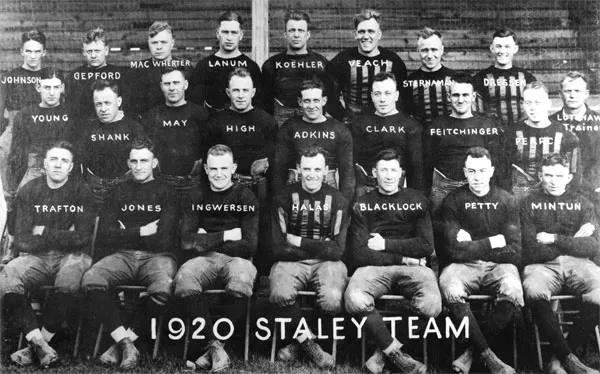On this day in 1922, the Decatur Staleys officially became the Chicago Bears, coinciding with the APFA’s rebranding to the NFL, marking a historic franchise rebirth.

On this day in 1922, the Decatur Staleys officially became the Chicago Bears, coinciding with the APFA’s rebranding to the NFL, marking a historic franchise rebirth.
The history of American football is rich with stories of evolution, resilience, and iconic transformations. Among these, the rebranding of the Decatur Staleys to the Chicago Bears on this day in 1922 stands as a pivotal moment—marking not only a franchise rebirth but also the formal birth of the National Football League (NFL). This event embodies the growth of professional football from regional leagues to a national spectacle and reflects the deep roots of the sport in American culture.
This article delves into the origins of the franchise, the significance of the rebranding, the broader context of professional football in the early 20th century, and the cultural and sporting implications of this transformation. Through this exploration, we appreciate how one franchise’s evolution encapsulates the broader development of football into America’s premier sport.
The Origins of the Decatur Staleys
Formation and Early Years (1919-1920)
The story begins in 1919, shortly after World War I, in Decatur, Illinois. The Decatur Staleys were founded by the A.E. Staley Manufacturing Company, primarily as a company-sponsored football team. Their initial purpose was to promote team spirit among employees and serve as a local entertainment fixture. The team was named after the Staley company, which produced starch and other food products.
In their early years, the Staleys competed in regional competitions, gaining a reputation for their competitive spirit and organization. They played local teams and gradually moved into more organized leagues, reflecting the growth of football as a popular pastime in Illinois and the Midwest.
Transition to a Professional Franchise
By 1920, the Staleys’ organization had grown more serious about competitive play. Recognizing the sport’s potential as a professional enterprise, the team began to assemble more talented players, some of whom were paid, blurring the line between amateur and professional status. This period marks the beginning of the franchise’s transition from a local company team to a professional football entity.
The Formation of the American Professional Football Association (APFA)
In 1920, the early seeds of what would become the NFL were sown. The American Professional Football Association was founded, aiming to organize the growing number of professional teams across the Midwest. The Staleys joined this new league, which was initially a loose confederation of regional teams seeking stability and recognition.
The league’s first season saw various teams compete with inconsistent schedules, varying rules, and little national attention. The Staleys performed respectably, setting the stage for future growth.
The 1922 Rebranding: From Decatur Staleys to Chicago Bears
The Move to Chicago
In 1921, the franchise moved from Decatur to Chicago, seeking a larger market and greater exposure. This move was motivated by several factors:
- Market Size: Chicago offered a larger population base and more media coverage.
- Financial Opportunities: With a bigger city, the team could attract more fans and sponsorship.
- Stability and Growth: Relocating was seen as a step toward establishing a more prominent professional football presence.
The team was renamed the “Chicago Staleys” in honor of its roots but soon faced the challenge of establishing a new identity within a competitive sports landscape.
The Rebranding to the Chicago Bears
On September 17, 1922, a pivotal day in football history, the team officially became the Chicago Bears. This rebranding was driven by several factors:
- Ownership and Management Changes: The team was purchased by George Halas, a former player, coach, and prominent figure in the sport. Halas sought to craft a distinct identity for the team.
- Marketing and Branding: The name “Bears” was chosen to evoke strength, resilience, and a fierce competitive spirit—qualities that would resonate with fans and players alike.
- League Recognition: The rebranding coincided with the league’s formal transition from the APFA to the NFL, signaling a new era of professionalism and stability.
This transformation marked a new chapter, positioning the franchise as a foundational pillar of professional football.
The Significance of the Name “Bears”
The choice of the “Bears” nickname was strategic and symbolic. It aimed to create a powerful image, aligning the team with the animal’s reputation for strength and tenacity. The name also had marketing appeal, helping to attract fans and establish a lasting legacy.
Interestingly, the name “Bears” was not entirely new; it had been used previously by other teams or in informal contexts, but 1922 cemented its association with Chicago’s football franchise.
The Broader Context: The Evolution of Professional Football
The Landscape of American Football in the Early 20th Century
In the early 1900s, football was primarily a college sport, with amateur leagues and regional contests capturing local interest. Professional football was embryonic, often viewed as less prestigious and less organized than college football.
However, the early 1920s marked a turning point:
- Growing Popularity: Football’s physicality, strategy, and spectacle began drawing larger crowds.
- Media Coverage: Newspapers and radio started to broadcast games, increasing national interest.
- League Formation: The establishment of leagues like the APFA (later NFL) provided structure, legitimacy, and a platform for growth.
The Role of George Halas
George Halas was instrumental in transforming professional football. As a player and coach, he understood the sport’s appeal and had a vision for its future. His leadership in rebranding the team as the Bears and building a competitive roster laid the groundwork for decades of success.
Halas’s vision extended beyond the field—he recognized the importance of marketing, branding, and creating a team identity that could captivate fans.
The Transition from Regional to National
The move from local leagues and small-town teams to a national league was gradual. The NFL’s formation in 1922 was a milestone—formalizing the sport’s professional structure, establishing standardized rules, and creating a unified brand.
The Chicago Bears’ rebranding was emblematic of this shift, representing a move toward professionalism, marketability, and national recognition.
The Cultural and Sporting Significance of the 1922 Rebranding
Establishing a Legacy
The Chicago Bears would go on to become one of the most successful and iconic franchises in NFL history, with numerous championships, Hall of Fame players, and legendary moments. Their origins as the Decatur Staleys and subsequent rebranding are foundational to their identity.
The Rise of the NFL
The rebranding coincided with the NFL’s emergence as America’s premier football league. By adopting a powerful name and establishing a strong team identity, the Bears contributed to the league’s burgeoning reputation and popularity.
Impact on Fan Culture
The Bears’ transformation helped cultivate a loyal fan base and a regional identity tied to Chicago’s sports culture. The team’s branding, emblematic of strength and resilience, resonated with fans during the city’s growth and economic development.
The Broader Cultural Context
The 1920s were a transformative decade for America—economically, socially, and culturally. The rise of professional football paralleled the country’s modernization, urbanization, and entertainment industry expansion.
The Bears’ rebranding reflected these changes, embracing a modern, aggressive identity aligned with America’s burgeoning consumer culture.
The Significance of the Date: Why 1922 Matters
The Official Transition
While the franchise’s origins date back to 1919, 1922 marks the official rebranding, renaming, and establishing the team as the Chicago Bears. This date symbolizes a turning point from regional team to national franchise.
The League’s Rebranding
The same day, the league officially changed its name from the APFA to the NFL. This parallel rebranding signified the formal establishment of a professional football league with national ambitions.
Cultural and Historical Impact
This dual event encapsulates the moment when professional football shed its local, informal roots and embraced a broader identity. The NFL’s founding laid the groundwork for the sport’s explosive growth over the subsequent century.
The Legacy of the Chicago Bears
A Historic Franchise
The Bears have become one of the most storied franchises in NFL history, with multiple championships, legendary players (Walter Payton, Dick Butkus, Mike Ditka), and iconic moments.
A Symbol of Resilience
Their origin story reflects resilience and adaptation—moving from a small-town team to a major league powerhouse. Their rebranding in 1922 set the stage for decades of success and cultural influence.
Continuing Relevance
Today, the Bears’ history, including the 1922 rebranding, is celebrated by fans, historians, and sports enthusiasts. It reminds us of the sport’s humble beginnings and the power of branding and identity in building a legendary franchise.
On this day in 1922, the Decatur Staleys officially became the Chicago Bears, coinciding with the league’s transition from the APFA to the NFL. This event was more than a simple name change; it was a symbol of the sport’s evolution from regional pastime to national obsession.
The rebranding reflected strategic vision, cultural shifts, and the ambition to create a resilient, powerful identity that would resonate for generations. It marked the birth of one of football’s most iconic franchises and the formal recognition of the NFL as America’s premier football league.
The story of the Bears’ transformation encapsulates the broader journey of professional football—its struggles, growth, and eventual dominance in American sports culture. Their legacy is a testament to the enduring appeal of the game and the importance of branding, tradition, and resilience in shaping a sporting dynasty.
As fans continue to cheer and celebrate the Bears’ storied history, they commemorate a historic day that laid the foundation for one of the most beloved sports leagues in the world. The 1922 rebranding remains a defining moment—heralding a new era of football that has captivated millions across generations.









